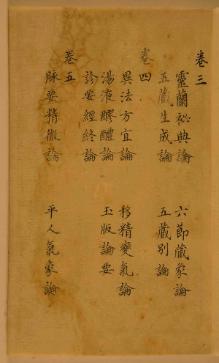Huangdi neijing
The Huángdì Nèijīng (Chinese 黄帝内經), also known as Nèijīng (内 經), is one of the oldest standard works of Chinese medicine . It is translated as "Inner Classic of the Yellow Prince", "Book of the Yellow Emperor on Internal Medicine" and "The Medicine of the Yellow Emperor" and consists of two large parts. This medical framework is fundamental and trend-setting for training within Chinese medicine to this day. It was included in the list of World Document Heritage by UNESCO .
History of origin
Since the Han dynasty (漢朝 / Hàncháo - approx. 206 BC to 220 AD) and the Jin dynasty (晋朝, Jìncháo - approx. 265–420 AD) known as Jiǔjuàn (九 卷 - "9 volumes") or Zhēnjīng (针 经 - "Meridian")
Since the Tang Dynasty (唐朝 / Tángcháo - approx. 618–907 AD) known as Língshū (灵枢 - "pivot of the structural force")
Content and structure
The entire work of Huángdì Nèijīng is divided into 18 volumes, which consist of a total of 162 chapters. The first nine volumes contain the Huángdì Nèijīng Sùwèn (黄帝内经 素 问) - or Sùwèn for short (素 问). This part is translated as "simple questions" or "unbiased questions". There, in a conversation with his master Qí Bó (岐 伯) , Huángdì mainly deals with the natural laws between man and nature, man and heaven and how one can bring all forces into harmony with one another. These questions and insights form the foundation of the fundamental philosophy of Chinese medicine.
The other nine volumes were only added over the centuries and were always known under different names (see history of origin). Since the Tang dynasty, these volumes have been referred to as "Língshū" ("pivot point of the structural force") and deal primarily with the external application of forms of therapy such as acupuncture and moxibustion, as well as organ and meridian theory.
Authors
Huángdì himself and his master Qí Bó (岐 伯) are known as authors of the Huángdì Nèijīng Sùwèn .
The second part ("Língshū") is supposed to be a compilation of works by different authors from different eras.
literature
- 民囯 出版社 / Mín Guó Chū Bǎn Shè (Ed.): 黄帝内经 / Huáng Dì Nèi Jīng. 大连 / Dà Lián 1912.
- 周海平 / Zhōu Hǎi Píng: 黃帝内經 大 詞典 / Huáng Di Nèi Jīng Dà Cí Diǎn. 中医 古籍 出版社 / Zhōng Yī Gǔ Jí Chū Bǎn Shè, 北京 / Běijīng 2008, ISBN 9787801744371 .
Individual evidence
- ↑ Huang Di Nei Jing 《黄帝内经》 (Yellow Emperor's Inner Canon) | United Nations Educational, Scientific and Cultural Organization. Retrieved August 28, 2017 .
- ↑ a b 周海平 / Zhōu Hǎi Píng: "黃帝内經 大 詞典 / Huáng Dì Nèi Jīng Dà Cí Diǎn"中医 古籍 出版社 / Zhōng Yī Gǔ Jí Chū Bǎn Shè, 北京 / Běijīng 2008, ISBN 9787801744371 .
- ↑ Wu Tian Ming Gong Jue / Frank Behrendt / Yun Yi Na: First aid with Chinese emperor medicine - advice for a natural home "pharmacy". Specialized publisher for Traditional Chinese Medicine & Eastern Sciences, 2nd edition, Stralsund 2010, ISBN 978-3-941814-03-5 .


